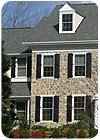

The stone for the project was supplied by Rolling Rock Building Stone, Inc., of nearby Boyertown, PA. “This project is a spec home that a developer was going to stucco and use Cultured Stone as the veneer for the front,” explained Terrence Meck of Rolling Rock. “John Endy, our Regional Sales Manager, presented our RealStone Veneer™ thin stone veneer brand, and it was accepted and installed.”
Meck explained that the thin stone veneer was a custom blend of several of Rolling Rock’s fieldstone colors. Included are Huntington Gray®, Brookfield Buff®, and Clover Creek™ varieties. “The stone is fieldstone that is quartzitic sandstone by geology. We quarry it here in Pennsylvania from multiple mines in Berks and Schuylkill Counties,” he said. “We use current sawing technology available from manufacturers like Park Industries to saw our stone thin. The return corners are sawn into the shape of an ‘L’ so that the stone appears to be full-thickness building stone. We are proud that 100% of the flats and corners we produce as part of our RealStone Veneer brand are produced without the use of chop saws.”
In all, the project utilized approximately 900 square feet of stone, and the pieces were randomly sized with irregular fieldstone shapes. It was installed in a standard thin veneer application.
Ultimately, by demolishing and removing the original home, the developer was able to build a new residence with a larger size and a custom floor plan. That strategy - along with the use of natural stone - proved to be a success. “Once the installation of the RealStone Veneer was completed, the home sold in very short order,” Meck said.